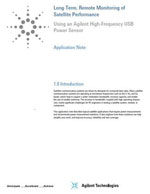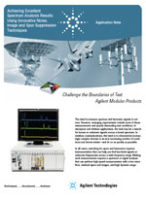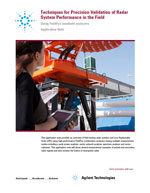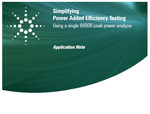Test and Measurement Products
March 17, 2014
AR RF/Microwave Instrumentation offers a broad range of power amplifiers covering DC to 45 GHz with output power ranging from 1 to 16,000 watts. While applications include Electromagnetic Compatibility testing (EMC), RF component testing, physics (plasma generation) and chemistry (mass spectroscopy) applications, military (jammers, radar), material testing (ultrasound), medical diagnostic testing (NMR, MRI) and general lab use, this applications note focuses on a line of amplifiers that has been optimized for wireless telecommunications test use.
March 17, 2014
This application note describes typical satellite applications that require power measurements and recommends power measurement solutions. It also explains how these solutions can help simplify your work, and improve accuracy, reliability and test coverage. Also covered are new sensor functions such as built-in Gamma and S-parameter corrections and real time measurement uncertainty calculations for improved accuracy.
March 17, 2014
The need to measure spurious and harmonic signals is not new. However, emerging requirements include more of these measurements and specify demanding test conditions. In aerospace and defense applications, the task may be a search for known or unknown signals across a broad spectrum. In wireless communications, the need is to characterize increasingly complex devices in an ever-expanding number of conditions and device states - and do so as quickly as possible.
March 17, 2014
This application note provides an overview of field testing radar systems and Line Replaceable Units (LRU) using high-performance� FieldFox combination analyzers having multiple measurement modes including a peak power analyzer, vector network analyzer, spectrum analyzer and vector voltmeter. This application note will show several measurement examples of pulsed and secondary radar signals and also reviews the basics of� monopulse radar.
January 17, 2014
Cloud computing, smart phones, and LTE services are causing a large increase in network traffic. Instantaneous traffic rates at internet data centers have reached 1 Tbit/s. Supporting this increased traffic, speed of IT equipment used in high-end services in data centers must be increased. This white paper discusses challenges introduced at these higher data rates and how Vector Network Analyzers can help meet these.
December 17, 2013
The Boonton model 55006 USB Peak Power Sensor and 4542 benchtop Power meter used with model 57006 Peak Power sensor or model 51011 EMC power sensors are the instruments of choice for capturing, displaying and analyzing RF power for automotive EMC and RF immunity testing. This application paper focuses on discussing the usage of peak power meters in RF immunity testing for EMC purposes.
December 17, 2013
Semiconductor manufacturing test engineers face increased broadband millimeter wave (MMW) on-wafer testing challenges. Developing accurate models often requires measuring frequencies ranging from near DC up to 100+ GHz. Achieving accurate, stable measurements over extended time periods is challenging. This white paper discusses the impact of calibration downtime during on-wafer testing and how to enable longer time periods between calibrations.
December 17, 2013
In most power added efficiency (PAE) test setups, multiple instruments are used to measure RF, voltage, and current. Measurements may require the use of an RF power meter or digital oscilloscope (DSO) with diode detectors to determine the RF power, while digital multimeters are used to measure voltage and current. The Agilent Technologies 8990B peak power analyzer (PPA) provides an alternative setup which allows power added efficiency testing to be done on a single instrument.
November 19, 2013
This white paper describes new methodology and instrumentation for minimizing measurement uncertainty when measuring RF power at power levels of up to 100 W below 1 GHz. The paper discusses two commonly used methods: using low-power sensors traceable through microcalorimeters, and direct measurement of high power using a flow calorimeter that converts the electrical energy from an RF source into thermal energy via a liquid-cooled resistive load. While both methods are functional, the flow calorimeter carries advantages in measurement uncertainties and process automation. The paper outlines a new approach that improves measurement accuracy with greater simplicity.
November 19, 2013
The most recent 802.11 standard presents some challenges as discussed in The Next Evolution of Wireless LAN white paper. It is not surprising that test engineers have been scrambling to find the right test equipment to test this standard. Many test engineers have now realized that the old method of finding an expensive boxed instrument with the best performance numbers is now dead. Why, you may ask? The answer is simple: test engineers are getting starved for resources, mainly time, money, and space. The modern breed of test engineers is already using intuitive new technologies to reduce space and decrease test and development time all in a reduced budget. National Instruments is helping test engineers address these challenges with user-programmable FPGA-based instrumentation. This paper discusses the benefits of using an open field-programmable gate array (FPGA) for 802.11ac testing specifically.








